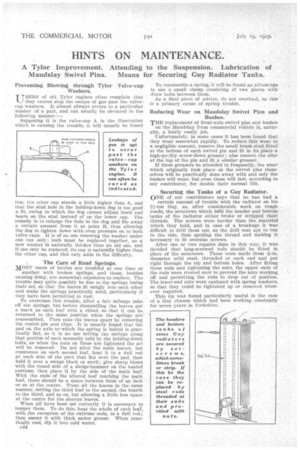HINTS ON MAINTENANCE.
Page 66

If you've noticed an error in this article please click here to report it so we can fix it.
A Tylor Improvement. Attending to the Suspension. Lubrication of Maudslay Swivel Pins. Means for Securing Guy Radiator Tanks.
Preventing Blowing through Tylor Valve-cap Washers.
USERS of old Tylor engines often complain that they cannot stop the escape of gas past the valvecap 'washers. It almost always occurs to a particular washer of a pair, and can usually be obviated in the following manner:—
Supposing it is the valve-cap which is causing the trouble, it
A in the illustration will usually be found
lima the other cap stands a little higher than A, and hat the stud hole in the holding-down dog is too good a fit, owing to which the dog cannot adjust itself and bears on the stud instead of on the lower cap. The remedy is to enlarge the hole in the dog and file away a certain amount from it at point B, thus allowing the dog to tighten down with. even pressure on to both valve caps, it is of no use renewing the washer under one cap only; both must be replaced together, as a new washer is naturally thicker than an old one, and if one only be replaced, its cap is naturally higher than the other cap, and this only adds to the difficulty.
The Care of Road Springs. MOST users of lorries are troubled at one time or another with broken springs, and these, besides causing delay, are somewhat expensive to replace. The trouble may quite possibly be due to the springs losing their set, so that the leaves .fit snugly into each other and make the springs practically solid, particularly if they have been permitted to rust.
To overcome this trouble, after a fair mileage take off the springs, but before dismantling the leaves pat a mark on each leaf with a chisel, so that it can be, returned to the same position when the springs are reassembled. Then take the leaves apart by removing the centre pin and clips. It is usually found that the pad on the axle to-which the spring is bolted is practically flat, so it is no use setting the springs along that portion of each normally held by the holding-down bolts, as when the nuts on these are tightened the set will be removed. Do not alter the main leaves, but commence on each second leaf, heat it to a dull red at each side of the part that fits over the pad, then hold it over a swage block or anvil; give sharp blows with the round side of a sledge-hammer on the heated portions, then place it by the side of the main leaf, With the ends of the altered leaf touching the main leaf, there should be a space between them of an inch or so at the centre. Treat all the leaves in the same manner, setting the third leaf to the second, the fourth to.the third, and so on, but allowing a little less space at the centre for the shorter leaves.
When all have been set correctly it is necessary to temper them. To do this, heat the whole of each leir, with the exception of the extreme ends, to a dull red; then smear it with thick motor grease. When practically cool, dip it into cold water. • To reassemble a spring, it will be found an advantage to use a small clamp consisting of two plates with draw bolts between them. '
As a final piece of advice, do not overload, as this is a primary cause of spring trouble. • Reducing Wear on Maudslay Swivel Pins and Bushes.
THE replacement of front-axle swivel pins and bushes on the Maudslay 5-ton commercial vehicle is, naturally, a fairly costly job.
Unfortunately, in some cases it has been found that they wear somewhat rapidly. To reduce this wear to a negligible amount, remove the small brass stud fitted at the bottom of each swivel pin and fit in its place a high-quality screw-down greaser; also remove tile oiler at the top of the pin and fit a similar greaser.
If these greasers be attended to frequently, the wear which originally took Place on the swivel pins themselves will be practically done away with and only the bushes will wear, but even these Will last, according to our contributor, for double their normal life.
Securing the Tanks of a Guy Radiator. ONE of our contributors saYs that he has had a certain amount of trouble with the radiator on his 21-ton Guy, as, after considerable work on rough . roads, the setscrews which held the header and bottom tanks of the radiatoreither broke or stripped their threads. The screws. were harder than the material which they held, and in case of a breakage it was difficult to drill them out, as the drill was apt to run to the side, thus spoiling the thread and Making it necessary to fit oversize screws. After one or two repairs done in this way, it was decided that long-screwed rods should be fitted in Place of the setscrews. These were made from k-in. diameter mild steel, threaded at each end and put right through the top and bottom holes. After fitting, these rods and tightening the nuts, the upper ends of the rods were riveted over to prevent the nuts working off and. perMitting the rods to drop out of position. The lower-end nuts were equipped with 'spring washers, so that they could be tightened up or removed whenever required. This tip was found particularly useful in the ease of a Guy chassis which had been working constantly for seven years in Yorkshire.












































































































